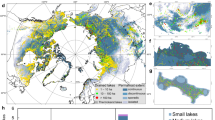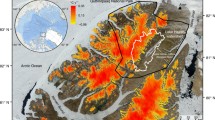Abstract
Globally, ecosystem services are threatened by increasing urbanization and more variable precipitation patterns driven by climate change. However, how these drivers interact over long-time scales to affect underlying processes remains poorly understood, hindering our ability to predict their long-term consequences. Here, we use long-term data spanning nearly a century to investigate changes in hydrologic attributes for two lakes in the Upper Midwest with urbanizing watersheds. We quantified flashiness—the variability of runoff rate, volume, or stage-level of waterways—to investigate the concurrent impacts of urbanization and climate change on flashiness and flooding potential. Our results indicate that flashiness generally increased for both lakes over the period of 1916–2013, although this overall trend consists of sub-periods of increase and decrease. Increasing impervious surface area has been the stronger driver of flashiness historically; however, our results suggest that the impact of urbanization may reach a threshold, such that saturation effects would cause large magnitude precipitation events to become a relatively stronger driver of flashiness. Increasing flashiness indicates an increase in flooding potential, documented by increases in the 10- and 100-year flood threshold levels as large as 30 cm. Since flashiness is strongly related to the provisioning of multiple ecosystem services, the methodology and results presented here provide a unique approach to gain insight into how non-linear interactions between global change drivers, at multiple time scales, impact the simultaneous provision of multiple services.






Similar content being viewed by others
References
Akaike H. 1973. Information theory and an extension of the maximum likelihood principle. International Symposium on Information Theory, 2nd, Tsahkadsor, Armenian SSR, pp 267–81.
Alberti M. 2005. The effects of urban patterns on ecosystem function. Int Reg Sci Rev 28:168–92.
Allan JD. 2004. Landscapes and riverscapes: the influence of land use on stream ecosystems. Ann Rev Ecol Evol Syst 35:257–84.
Arnold CL Jr, Gibbons CJ. 1996. Impervious surface coverage. J Am Plan Assoc 62:243.
Baker DB, Richards RP, Loftus TT, Kramer JW. 2004. A new flashiness index: Characteristics and applications to Midwestern rivers and streams. J Am Water Resour Assoc 40:503–22.
Bennett EM, Reed-Andersen T, Houser JN, Gabriel JR, Carpenter SR. 1999. A phosphorus budget for the Lake Mendota watershed. Ecosystems 2:69–75.
Booth DB. 1991. Urbanization and the natural drainage system—impacts, solutions, and prognoses. Inst Environ Stud 7:93–118.
Booth DB, Karr JR, Schauman S, Konrad CP, Morley SA, Larson MG, Henshaw PC, Nelson EJ, Burges SJ. 2001. Urban stream rehabilitation in the Pacific Northwest. Wash Water Resour 12:1–11.
Brauman KA, Daily GC, Duarte TK, Mooney HA. 2007. The nature and value of ecosystem services: an overview highlighting hydrologic services. Ann Rev Environ Resour 32:67–98.
Bronstert A, Niehoff D, Bürger G. 2002. Effects of climate and land-use change on storm runoff generation: present knowledge and modelling capabilities. Hydrol Process 16:509–29.
Buja A, Hastie T, Tibshirani R. 1989. Linear smoothers and additive models. Ann Stat 17:453–510.
Carpenter SR, Caraco NF, Correll DL, Howarth RW, Sharpley AN, Smith VH. 1998. Nonpoint pollution of surface waters with phosphorus and nitrogen. Ecol Appl 8:559–68.
Carpenter SR, Lathrop RC, Nowak P, Bennett EM, Reed T, Soranno PA. 2005. The ongoing experiment: restoration of Lake Mendota and its watershed. Long-Term Dyn Lakes Landsc 25:236–56.
Carpenter SR, Brock WA, Folke C, van Nes EH, Scheffer M. 2015. Allowing variance may enlarge the safe operating space for exploited ecosystems. Proc Natl Acad Sci 112:14384–9.
Commission, D. C. R. P. 1992. Yahara-Monona priority watershed plan. Dane County, Madison, Wis.
Curtis JT. 1959. The vegetation of Wisconsin: an ordination of plant communities. Madison: University of Wisconsin Press.
Doerr Stefan H, Thomas Andrew D. 2000. The role of soil moisture in controlling water repellency: new evidence from forest soils in Portugal. J Hydrol 231:134–47.
Engle RF. 1982. Autoregressive conditional heteroscedasticity with estimates of the variance of United Kingdom inflation. Econometrica 50(4):987–1007.
Fewster RM, Buckland ST, Siriwardena GM, Baillie SR, Wilson JD. 2000. Analysis of population trends for farmland birds using generalized additive models. Ecology 81:1970–84.
Fletcher TD, Andrieu H, Hamel P. 2013. Understanding, management and modelling of urban hydrology and its consequences for receiving waters: a state of the art. Adv Water Resour 51:261–79.
Foley JA, DeFries R, Asner GP, Barford C, Bonan G, Carpenter SR, Chapin FS, Coe MT, Daily GC, Gibbs HK et al. 2005. Global consequences of land use. Science 309:570–4.
Foster HA. 1924. Theoretical frequency curves and their application to engineering problem. Trans Am Soc Civil Eng 88(1):142–73.
Franczyk J, Chang H. 2009. The effects of climate change and urbanization on the runoff of the Rock Creek basin in the Portland metropolitan area, Oregon, USA. Hydrol Process 23:805–15.
Gillon S, Booth EG, Rissman AR. 2015. Shifting drivers and static baselines in environmental governance: challenges for improving and proving water quality outcomes. Reg Environ Change 16(3):1–17.
Grimm NB, Faeth SH, Golubiewski NE, Redman CL, Wu J, Bai X, Briggs JM. 2008. Global change and the ecology of cities. Science 319:756–60.
Guisan A, Edwards TC, Hastie T. 2002. Generalized linear and generalized additive models in studies of species distributions: setting the scene. Ecol Model 157:89–100.
Hastie T, Tibshirani R. 1987. Generalized additive models: some applications. J Am Stat Assoc 82:371–86.
IPCC. 2013. Climate change 2013: the physical science basis. In: Stocker TF, Qin D, Plattner G-K, Tignor M, Allen SK, Boschung J, Nauels A, Xia Y, Bex V, Midgley PM, Eds. Contribution of working group i to the fifth assessment report of the intergovernmental panel on climate change. Cambridge: Cambridge University Press.
Keeler BL, Polasky S, Brauman KA, Johnson KA, Finlay JC, O’Neill A, Dalzell B. 2012. Linking water quality and well-being for improved assessment and valuation of ecosystem services. Proc Natl Acad Sci 109(45):18619–24.
Lathrop RC. 1992. Lake Mendota and the Yahara River chain. In: Kitchell JF, Ed. Food web management. New York: Springer.
Lathrop RC, Bradbury K, Halverson B, Potter K, Taylor D. 2005. Responses to urbanization. LakeLine 25:39–46.
Lathrop RG, Tulloch DL, Hatfield C. 2007. Consequences of land use change in the New York-New Jersey highlands, USA: landscape indicators of forest and watershed integrity. Landsc Urban Plan 79:150–9.
Leopold LB. 1968. Hydrology for urban land planning–a guidebook on the hydrologic effects of urban land use. US Geol Surv Circ 554:18.
Lovell ST, Taylor JR. 2013. Supplying urban ecosystem services through multifunctional green infrastructure in the United States. Landsc Ecol 28(8):1447–63.
Maes J, Teller A, Erhard M, Liquete C, Braat L, Berry P, Egoh B, Puydarrieux P, Fiorina C, Santos F et al. 2013. Mapping and assessment of ecosystems and their services. An analytical framework for ecosystem assessments under action. Ecosyst Serv 5:1–58.
Magnuson JJ, Kratz TK, Benson BJ. 2006. Long-term dynamics of lakes in the landscape: long-term ecological research on north temperate lakes. Oxford: Oxford University Press.
Metzger MJ, Rounsevell MDA, Acosta-Michlik L, Leemans R, Schröter D. 2006. The vulnerability of ecosystem services to land use change. Agric Ecosyst Environ 114:69–85.
Meyer Judy L, Paul Michael J, Keith Taulbee W. 2005. Stream ecosystem function in urbanizing landscapes. J North Am Benthol Soc 24(3):602–12.
Millennium Ecosystem Assessment (MEA). 2005. Ecosystems and human well-being. Washington, DC: Island Press.
Naiman RJ, Decamps H. 1997. The ecology of interfaces: riparian zones. Ann Rev Ecol Syst 28:621–58.
Paul MJ, Meyer JL. 2001. Streams in the Urban landscape. Ann Rev Ecol Syst 32:333–65.
Pickett STA, Cadenasso ML, Grove JM, Boone CG, Groffman PM, Irwin E, Kaushal SS, Marshall V, McGrath BP, Nilon CH, Pouyat RV, Szlavecz K, Troy A, Warren P. 2011. Urban ecological systems: scientific foundations and a decade of progress. J Environ Manag 92:331–62.
Poelmans L, Rompaey AV, Ntegeka V, Willems P. 2011. The relative impact of climate change and urban expansion on peak flows: a case study in central Belgium. Hydrol Process 25:2846–58.
Poff N. 1996. A hydrogeography of unregulated streams in the United States and an examination of scale-dependence in some hydrological descriptors. Freshwater Biol 36:71–9.
Qiu J, Turner MG. 2013. Spatial interactions among ecosystem services in an urbanizing agricultural watershed. Proc Natl Acad Sci 110:12149–54.
Qiu J, Turner MG. 2015. Importance of landscape heterogeneity in sustaining hydrologic ecosystem services in an agricultural watershed. Ecosphere 6:1–19.
Raudsepp-Hearne C, Peterson GD, Bennett EM. 2010. Ecosystem service bundles for analyzing tradeoffs in diverse landscapes. Proc Natl Acad Sci 107:5242–7.
Rodríguez JP, Beard TD Jr, Bennett EM, Cumming GS, Cork SJ, Agard J, Dobson AP, Peterson GD. 2006. Trade-offs across space, time, and ecosystem services. Ecol Soc 11:28.
Sánchez-Rodríguez R, Seto KC, Simon D, Solecki WD, Kraas F, Laumann G. 2005. Science plan: urbanization and global environmental change. IHDP report.
Schneider A, Logan KE, Kucharik CJ. 2012. Impacts of urbanization on ecosystem goods and services in the US Corn Belt. Ecosystems 15:519–41.
Turner MG, Donato DC, Romme WH. 2013. Consequences of spatial heterogeneity for ecosystem services in changing forest landscapes: priorities for future research. Landsc Ecol 28:1081–97.
United Nations. 2008. World urbanization prospects: the 2007 revision. New York: Population Division.
U.S. Department of the Interior, Geological Survey, Office of Water Data Coordination. 1982. On Water Data, I. Guidelines for determining flood flow frequency.
Venables WN, Ripley BD. 2002. Modern applied statistics with S. New York: Springer.
Wegener MW. 2001. Long-term land use/cover change patterns in the Yahara Lakes region and their impact on runoff volume to Lake Mendota. University of Wisconsin–Madison.
Wenger SJ, Roy AH, Jackson CR, Bernhardt ES, Carter TL, Filoso S, Gibson CA, Hession WC, Kaushal SS, Martí E, Meyer JL, Palmer MA, Paul MJ, Purcell AH, Ramírez A, Rosemond AD, Schofield KA, Sudduth EB, Walsh CJ. 2009. Twentysix key research questions in urban stream ecology: an assessment of the state of the science. J N Am Benthol Soc 28:1080–98.
Wisconsin’s Changing Climate: Impacts and Adaptation. 2011. Wisconsin Initiative on Climate Change Impacts. Nelson Institute for Environmental Studies, University of Wisconsin-Madison and the Wisconsin Department of Natural Resources, Madison, Wisconsin.
Wood SN. 2006. Generalized additive models: an introduction with R. Boca Raton: CRC Press.
Yee TW, Mitchell ND. 1991. Generalized additive models in plant ecology. J Veget Sci 2:587–602.
Zedler JB. 2003. Wetlands at your service: reducing impacts of agriculture at the watershed scale. Front Ecol Environ 1:65–72.
Zehe E, Becker R, Bárdossy A, Plate E. 2005. Uncertainty of simulated catchment runoff response in the presence of threshold processes: role of initial soil moisture and precipitation. J Hydrol 315(1):183–202.
Acknowledgments
We are grateful for comments from M. Turner, S. Carpenter, R. Lathrop, and M. Werner, and to J. Zhu for statistical insight. This is work is partially supported by the National Science Foundation under grants DEB-1038759 and NSF-IGERT and DGE-1144752.
Author information
Authors and Affiliations
Corresponding author
Electronic supplementary material
Below is the link to the electronic supplementary material.
Rights and permissions
About this article
Cite this article
Usinowicz, J., Qiu, J. & Kamarainen, A. Flashiness and Flooding of Two Lakes in the Upper Midwest During a Century of Urbanization and Climate Change. Ecosystems 20, 601–615 (2017). https://doi.org/10.1007/s10021-016-0042-7
Received:
Accepted:
Published:
Issue Date:
DOI: https://doi.org/10.1007/s10021-016-0042-7




